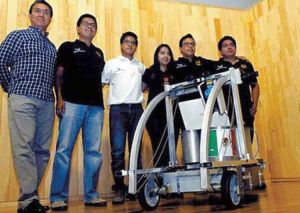Guadalajara, Jalisco, Mexico - The first prototype of a Mars explorer robot designed in Mexico by a team of 10 university students has gained the recognition of NASA and the International Astronautical Federation (IAF).
"It is a completely Mexican design," Bryan Perez, one of the members of the Mexican design team, said on Saturday.
The development team consists of nine engineering students from the National Autonomous University of Mexico (UNAM) and one from the National Polytechnic Institute.
"We are convinced that Mexico has the knowledge, the drive and the power to innovate in aerospace, which is just beginning here," said Perez.
The robot is equipped with two stereoscopic cameras to chart terrain and a third camera, below its body, to monitor samples collected by a pincer.
The robot also includes artificial vision, terrain mapping and route selection abilities. It is capable of searching, collecting and storing samples from the surface of Mars.
The development team has been awarded at the Sample Return Robot Challenge in 2015 and 2016, a competition organized by NASA for universities and companies to develop Mars rovers, said Perez.
"We are as good as any of the major universities in the United States who use the same technology and methodology. The only difference is that they have more resources to carry out their projects," he added.
The team has been working together for two years, with the development of the second prototype taking nine months and costing around 180,000 pesos ($9,285 USD) provided by UNAM, a technology company and the students themselves.
In late September, the team took the prototype to the 67th International Astronautical Congress in Guadalajara to exhibit it alongside the latest technology by giants in the field.
The prototype won the title of best team project, with the students receiving a trophy during the Congress' closing ceremony on September 30.
Their hope is now for NASA or another space agency to choose some of their components to be included on future missions to Mars.
Original article


